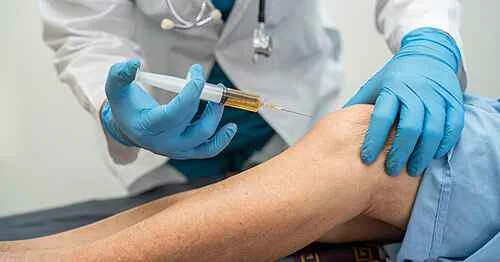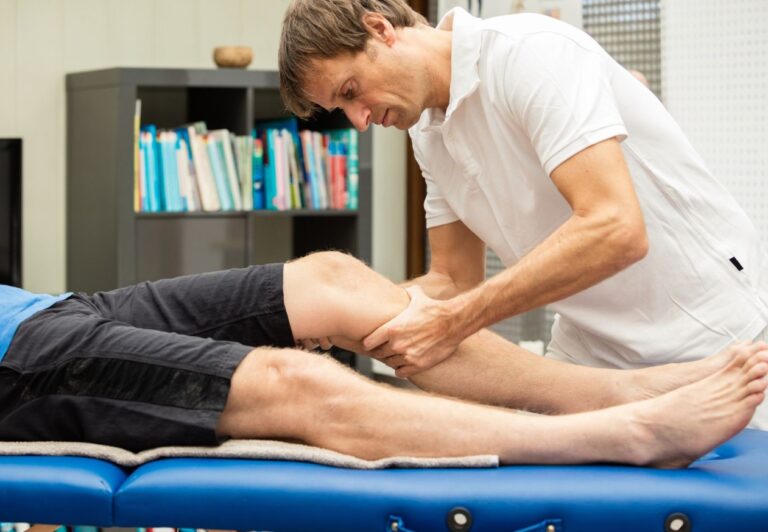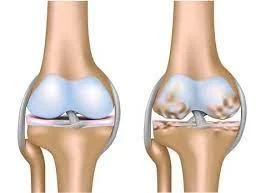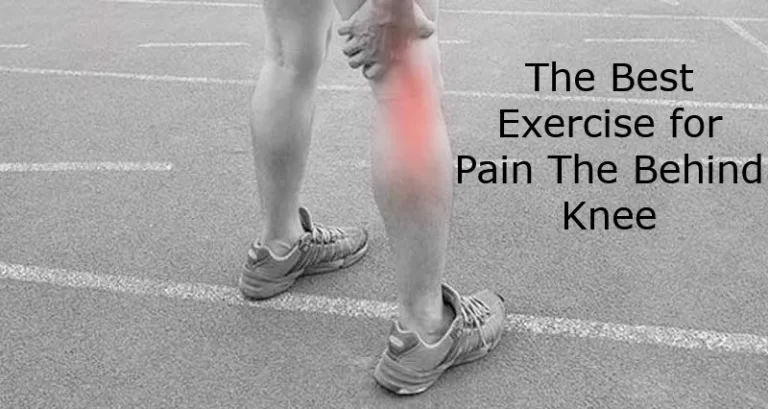Platelet-rich plasma Injection for Knee Osteoarthritis
Introduction
A new method for treating knee osteoarthritis (OA) pain includes giving injections of platelet-rich plasma (PRP). There’s a chance that researchers are investigating it at the moment.
Several PRP preparations have received approval from the FDA, but using PRP to treat knee osteoarthritis is not currently covered by this approval.
Current guidelines from the American College of Rheumatology and the Arthritis Foundation (ACR/AF) strongly advise against using this treatment because it is not yet completely established and organized. This means you cannot know how much is in your dose. However, more research may make it an affordable therapy option.
Over time, osteoarthritis (OA) has become a more common disease due to the increased life expectancy of modern medication. OA, which primarily affects the joints in our body, is the most common cause of disability worldwide.
Data from the Framingham osteoarthritis study showed that OA is similar to respiratory and cardiovascular diseases like chronic obstructive pulmonary disease, and it is equally frequent in that it causes long-term physical disabilities. Several studies have determined that OA affects about a quarter of a billion people worldwide.
Despite the lack of clarity around the true pathophysiology of OA, numerous definitions are given. For this study, we used the definition for osteoarthritis commonly cited as, characteristic structural alterations of the joint, involving focal degradation of articular cartilage and remodeling of subchondral bone with the formation of osteophytes at the joint border, as well as an illness defined by a person’s symptoms, involve pain, fatigue, mood alterations, and sleep disturbance.
The Kellgren-Lawrence system, a radiological classification system that has been in use for approximately 40 years, is a classical way of describing knee osteoarthritis (KOA). On a scale of 1 to 4, 2, 3, and 4 indicate mild, moderate, and severe, respectively. Knee osteoarthritis represents 83% of all cases of osteoarthritis (OA), and the disease’s prevalence is expected to rise dramatically. Figures as high as 673% more surgical procedures will be necessary in the United States by 2030, according to Kurtz et al.
Clear National Institute for Health and Care Excellence (NICE) guidelines are frequently utilized in the management of KOAs in the United Kingdom. These include addressing modifiable and non-modifiable risk factors involving weight loss and lifestyle modification. They also include multi-modal therapies that involve analgesics, injections, and ultimately when conservative management has failed, surgical options.
Patients received benefits to different degrees from all treatments. Exercise and enhancing general health are by far the approaches that have the greatest advantages for the treatment of KOA. In those patients with OA who are obese, this change is very successful in decreasing pain, which is a key complaint in KOA.
Amongst suggested analgesics are non-steroidal anti-inflammatory drugs (NSAID) which are very effective in decreasing pain. The dangers related to long-term NSAID use, especially in the elderly, may, however, exceed the potential benefits of trying to treat KOA. Injections called intra-articular (IA) are an alternative form of long-term therapeutic management. Steroid injections are known to be controversial at best and have inconsistent results, with some patients reporting temporary positive benefits.
All steroid preparations, however, are known to be chondrotoxic if taken regularly. Despite being costly to make, hyaluronic acid (HA) is widely used in the USA but isn’t suggested by NICE in the United Kingdom. In addition to those mentioned tools, platelet-rich plasma (PRP) IA injections have become a widely used technique in management in recent times. Autologous growth factors that support tissue repair are given in this method.
Further, patients receiving PRP injections are instructed to keep away from taking NSAIDs while receiving the procedure. Past investigations, such as Schippinger et al. Discuss ways that NSAIDs affect the method that platelets function in patients who take PRP injections. Decreased oxygen consumption by cyclooxygenase impacts platelet aggregation, which in turn reduces the release of bioactive substances like growth factors. Therefore, if provided when combined with PRP injections, this would lessen their effectiveness.
Although the interventional procedures advisory committee has yet to develop specific audit standards for the data gathered, NICE has currently given the following statement supporting the use of PRP in KOA. Clinicians are encouraged to assess their practices in light of the procedure’s results.
The evidence encouraging PRP injections in the knee is covered in three major double-blind randomized control trials (RCTs), which are discussed above. To figure out if there is a therapeutic benefit, these studies were done with patients receiving PRP injections and compared to controls of normal saline or hyaluronic acid.
Using the extensive WOMAC questionnaire and scoring system, three primary outcomes were observed: pain, stiffness, and physical function of the joint. In all three domains, these three RCTs demonstrated a benefit. Patients with mild to moderate osteoarthritis in their knees, or Kellgren-Lawrence grade 2 or 3, are the most common recipients of PRP injections because they consistently experience the most relief from the condition.
What is Plasma?
The fluid component of blood, known as plasma, serves as a route for red and white blood cells as well as other substances that are carried through the bloodstream. Plasma is mostly water but also involves proteins, nutrients, glucose, and antibodies, among other components.
What are Platelets?
Similarly to white and red blood cells, platelets are a typical part of blood. Platelets produce chemicals known as growth factors along with other proteins to regulate cell division, stimulate tissue regeneration, and aid in healing; these substances have no healing or restorative effects on their own. Furthermore, platelets aid in the clotting of blood; a person with low or broken platelets will bleed heavily from wounds.
An injection of platelet-rich plasma (PRP) can differ greatly from patient to patient because the term is not commonly used in the medical community. Variations occur for many reasons, including:
- Patient characteristics: Patients may have different blood components (e.g., different numbers of platelets).
- Processing of blood: The quantity of platelets and white blood cells in a PRP injection depends on how the patient’s blood sample is processed (such as centrifuged and filtered).
- Additives: Doctors may add substances to platelet-rich plasma (PRP) that are considered to improve the PRP’s healing capabilities.
It’s unknown how PRP composition and production affect how effective the therapy is. Patients thinking about platelet-rich plasma therapy should take the time to become informed about PRP until further research is performed.
What Is Platelet-Rich Plasma?
Thrombocytes, or platelets, are a type of blood cells. Their primary purpose is to aid in blood clotting. Your bone marrow produces them.
Growth factors are found in platelets. These proteins may help in the healing procedure following injuries.
How Does Platelet-Rich Plasma Work?
You will have a small quantity of blood drawn by a physician. Your blood will be placed in a centrifuge by them. This causes your blood to spin at various speeds until it divides into various layers. Platelet-rich plasma is one layer. Two to three times as many platelets as typical blood may be present in this layer of plasma.
After that, your affected area will get an injection of platelet-rich plasma. Your physician might apply a local anesthetic to numb that area first. For the first two weeks, the site may hurt more. It can take a few weeks before you find any progress. Finding better. Following therapy, your physician can recommend that you:
- For the first two days after your treatment, ice the area for 20 minutes every two to three hours. After the operation, some redness and swelling could show up.
- Non-steroidal anti-inflammatory drugs (NSAIDs) should not be taken right after therapy as this could obstruct the effects.
- Avoid taking part in any activities that strain the treated region.
- Before you start strenuous exercise like cycling and running, consult your doctor.
What Does Platelet-Rich Plasma Therapy Do?
The precise process by which PRP therapy may decrease symptoms of specific orthopedic conditions is unknown to experts. Osteoarthritis patients taking platelet-rich plasma (PRP) treatment speculate that the therapy may:
- Decrease inflammation and prevent the onset of osteoarthritis.
- Promote the growth of new cartilage.
- To decrease severe joint friction, increase the joint’s natural lubricating fluid production.
- Contain proteins that alter a patient’s pain receptors and decrease pain sensation.
Platelet-rich plasma may have all of these effects or none at all. More large-scale, high-quality clinical studies are required before scientists can know.
How does it work, and is it effective?
Your blood includes growth factors in a variety of platelets. By stimulating the development of new cells, PRP growth factors from your blood are thought to help tissues heal themselves when injected into an injured place.
In this method, PRP could support reversing existing tissue damage.
Research on PRP treatment for knee OA has yielded inconsistent results, and there is currently insufficient proof to support the treatment’s safety and efficacy.
According to a 2019 review, while much research supports PRP’s use, many others suggest it has no benefit.
A 2017 analysis examined 1,423 people across 14 randomised controlled trials. Results suggested that PRP may assist in managing pain associated with knee OA.
At the 3-, 6-, and 12-month follow-ups, the authors observed the following:
- Pain levels: Compared with placebos, PRP injections significantly decrease pain scores at each follow-up appointment.
- Physical function: Compared with controls, PRP significantly develops physical function at these follow-ups.
- Adverse effects: Though not any more severe than those caused by other injection kinds, a few people did have adverse side effects.
Although the results seem inspiring, there was a high risk of bias in 10 out of the 14 papers that were analyzed and a moderate risk in 4.
More studies are required to determine whether PRP could offer a suitable option to manage pain from OA of the knee.
Who can benefit from PRP?
PRP is an experimental therapy, and experts do not currently suggest its use. If you are considering PRP injections, begin by asking your doctor for their advice.
Little data indicates that PRP injections are safe and beneficial because they are still experimental. It’s also possible that your insurance policy won’t cover them.
Before beginning any experimental treatments, make sure you examine your doctor regularly and that the provider is properly qualified to give the treatment.
What happens during the procedure?
Your doctor will first take a small quantity of blood from your arm.
After that, they’ll centrifuge the blood sample to separate the constituent parts and generate a concentrated platelet suspension in plasma. At this point, variations in approach could result in varying quantities of each component.
After freezing your knee, a doctor will inject PRP into the knee’s joint area. To guide the injection, they could employ ultrasonography.
You will be able to return home after taking some time to relax. Since there can be pain and stiffness following the injection, you should make plans for a ride home.
What happens during recovery?
Following the operation, your doctor might recommend that you:
- During the first three days, ice your knee for 20 minutes every two to three hours.
- Take Tylenol to support and manage discomfort.
- Keep clear of NSAIDs like ibuprofen since they can cause issues with PRP’s potential to work.
- Take lots of rest and steer clear of activities that stress your knee.
- You may be required to use crutches or a walking frame for a few days to keep the weight off of your knee.
- During follow-up appointments, heed what is suggested by your doctor.
Are there risks?
Although PRP uses your blood, scientists believe it is generally safe.
However, an injection into the knee joint can entail some risks, involving:
- Local infection.
- Pain at the place of injection.
- Injury to the nerve, typically at the injection site.
According to the referenced 2017 review, some people reported:
- Pain and stiffness.
- A rapid heartbeat.
- Fainting and dizziness.
- Nausea and upset stomach.
- Sweating.
- Headache.
The adverse effects of other injections were not more severe than these, the researchers pointed out, and they were non-specific. Further, this kind of treatment can be costly and insurance companies may not pay for it.
Remember that given that this treatment is experimental, there can be unanticipated negative consequences.
What are my other treatment options?
There are various methods to manage OA-related pain and other symptoms. Weight management and exercise are key long-term strategies, but other options can give more immediate relief.
- Reduce OA pain.
- Apply ice and heat to the knee.
- Take over-the-counter NSAIDS, such acetaminophen (Tylenol) or ibuprofen (Advil, Motrin).
- Use prescription pain relief if your doctor advises it.
- Thought about utilizing medical equipment like a brace, walker, or cane.
- Apply capsaicin or NSAID-containing ointments.
- Consult a doctor about injection corticosteroids.
- If severe issues limit your mobility and quality of life, you may want to consider surgery.
Is Platelet-Rich Plasma Treatment Effective?
A variety of aspects affect how well platelet-rich plasma works, including:
- Your general well-being.
- Whether the injury you sustained was acute (sudden and serious) or chronic (developing over time).
- Preparing ready for the platelet-rich plasma therapy.
Platelet-rich plasma therapy has been proven to be ineffective in several randomized trials. However, certain clinical studies also supported its application.
Knee osteoarthritis. Work shows that certain forms of platelet-rich plasma therapy could be useful in treating low- to moderate-grade osteoarthritis in the knees.
Injecting platelet-rich plasma instead of placebo has been shown in certain tests to considerably reduce discomfort.
People’s physical abilities also considerably improved. These advantages are maintained at the 3-, 6-, and 12-month updates.
The use of platelet-rich plasma therapy is not suggested to people with osteoarthritis in the hip and knee by the Arthritis Foundation or the American College of Rheumatology. They say that there isn’t a standardization of methods or preparations for the treatment. This means that you cannot be certain of the contents of your dose.
The inability of knee cartilage to regenerate makes treating osteoarthritis in the knees challenging. The osteoarthritis condition has no known cure. Improving symptoms and postponing the need for knee replacement surgery are the main goals of treatment.
Chronic tendon injuries. Tennis elbow and other chronic tendon issues may benefit from the use of platelet-rich plasma. However, doctors show that platelet-rich plasma treatment might not be any more beneficial than usual therapy for other chronic tendon ailments such as jumper’s knee.
Fractures. Thus far, the treatment has not shown a significant advantage for fractures.
Knee Osteoarthritis Treated with PRP
Patients with knee osteoarthritis, a condition that doctors indicate will impact almost half of all Americans at some point in their lives, are often the subjects of research on PRP and osteoarthritis. The following discusses two clinical studies that look at using PRP to treat knee arthritis.
In one 2013 study, 78 patients (156 knees total) with osteoarthritis in both knees were involved.11 One PRP injection, two PRP injections, or a single placebo saline injection were given to each knee. After injection, the individuals’ knees were evaluated by researchers after three, six, and nine months. Researchers determined:
After one or two PRP injections, knee pain and stiffness subsided, and knee function recovered after three and six weeks. The beneficial effects began to decrease after six months, but pain and function remained better than they had been before PRP therapy. There was an increase in pain and stiffness as well as a decrease in knee function in the group that received placebo injections. The platelet-rich plasma used in this clinical investigation was filtered to remove white blood cells and had three times the platelet content of normal blood.
A second, smaller trial looked at people who had been suffering from minor knee discomfort for 14 months on average. A single PRP injection was given to each arthritic knee after an MRI was performed to assess joint degeneration. There were evaluations of the patient’s knees after one week, three months, six months, and a year. After a year, each knee was given a second MRI. Researchers discovered:
Most patients had less pain one year after a PRP injection than they did the year prior, but the pain did not always go away. According to MRIs, most knees did not show evidence of significant degenerative processes. The patients’ knee cartilage did not appear to repair, it may still be essential that their arthritis did not worsen. There is evidence to suggest that in arthritic joints, 4–6% of the cartilage breaks annually on average.
Cost of Platelet-Rich Plasma Treatment
A platelet-rich plasma therapy may run you somewhere from $750 to $2000 in total, not including doctor or facility prices. Multiple injections can be necessary for certain people. However, surgery for a range of musculoskeletal disorders can set you back $10,000 to $15,000.
Your insurance company might not pay for therapies using platelet-rich plasma because the FDA has not approved these treatments. These methods are not often covered by insurance companies. Get in touch with your insurance provider to discover more.
What’s the outlook?
Using your blood, PRP injections promote tissue progress in damaged areas. There is some evidence that this treatment may assist in managing pain associated with OA of the knee, but not enough to confirm that it works.
Experts do not currently suggest PRP injections for OA of the knee, due to the lack of standardization at the preparation stage.
Talk to your doctor before choosing to use PRP, and heed their advice if you’re considering it. Keep in mind that clinics can only offer this investigational medicine off-label.
PRP Does Not Work for Everyone
Not every clinical research shows that PRP decreases osteoarthritis symptoms.PRP injections performed no better than a placebo in several clinical trials. Not all patients gain a benefit from PRP, even in studies that do show treatment to be effective.
PRP proponents indicate that variations in PRP formulation or injection administration are the reason why PRP may not always be successful in treating symptoms; in other words, changes to variables like PRP preparation techniques, PRP injection volume, and injection frequency may reduce the benefits of PRP. They suggest that PRP therapy is just a brief trend with little practical use.
Perhaps PRP therapy, like other treatments for osteoarthritis, is best when used in conjunction with other therapies like physical therapy, or it may be helpful for some patients but not for others.
Conclusions
The conclusions support the effectiveness of the PRP injections for the KOA and indicate that pain decreased as soon as one month following the injection, with the greatest effects shown six months later. In further research, they suggest that data be gathered and documented just three times: during recruitment, one, and six months following administration. This would result in a shorter follow-up protocol.
FAQs
Does PRP help knee osteoarthritis?
PRP injections do help people with osteoarthritis improve their knee pain and function.
How much time do PRP injections in the knee last?
However, numerous studies show PRP injection-induced reduction can endure for up to nine months. However, that relief takes time to come. It can take a few weeks for the healing components to start healing after therapy.
What is the success rate of PRP knee injections?
Studies have nevertheless shown that PRP therapy can achieve a 90% success rate. For example, one study showed that PRP treatment significantly decreased pain and improved function in patients with knee osteoarthritis when compared to placebo injections.
Which injection is most effective for treating knee osteoarthritis?
Corticosteroids or hyaluronic acid injections have the potential to decrease inflammation and relieve pain. Other, more experimental injections, such as stem cells or platelet-rich plasma, may help damaged soft tissues repair and become pain-free.
Can I walk after the PRP injection?
Your orthopedic specialist may use a walking boot or sling to immobilize the treated joint during the PRP injection. You can also be advised to walk with crutches if you have received treatment for a knee, foot, or ankle issue.
How long does PRP last for osteoarthritis?
Patients may have a four- to six-week period before they see benefits from PRP injections. The platelet-rich plasma will help support further healing even after this window closes, perhaps lasting between six and nine months.
Is PRP better than knee replacement?
Given their capacity to stop cartilage loss and initiate the process of recovery, biological treatments using stem cells or platelet-rich plasma (PRP) raise the chance of avoiding major procedures like total knee replacements.
Can PRP regenerate knee cartilage?
The beneficial effects of intra-articular PRP treatment for knee osteoarthritis (OA) have been confirmed by its ability to reduce pain, symptoms, joint stiffness, quality of life, and the regeneration and repair of articular cartilage. Additionally, it has been shown to reduce related disability.
Is one PRP treatment enough for the knee?
Researchers found that following one or two PRP injections, knee pain and stiffness subsided, and knee function improved at six weeks and three months. The beneficial effects started to fade after six months, but pain and function remained better than they had been before PRP therapy.
Is PRP better than steroids for knee arthritis?
While cortisone shots can provide temporary comfort, they may also cause long-term harm to the joint or muscle. PRP shots, on the other hand, are more effective at decreasing inflammation and helping healing.
How many PRP injections are required to treat the knee?
It is suggested to get three PRP injections spaced one month apart, then get a maintenance injection every six months. For a minimum of 12 months, it can offer symptomatic reduction from arthritis pain. It’s been shown that delaying the need for knee replacement surgery!
What is the risk of PRP in the knee?
You can have some discomfort and bruising at the injection site after the treatment. The potential of a negative reaction greatly decreases with PRP injections are compared to other injectable drugs like corticosteroids because the injections are created entirely of your cells and plasma. Bleeding is one of the less frequent side effects of PRP injections.
What is not allowed after PRP?
Six weeks following the procedure, stay away from anti-inflammatory drugs (ibuprofen, naproxen, Celebrex, etc.). After having your PRP injection, the affected area might get more irritated. This is an area in the recovery process. For the next three days, ice the affected area three or four times a day for 15 minutes at a time.
Who should avoid PRP treatment?
PRP is thought to be safe for the majority of people, but it is not recommended for those with any of these medical conditions:
Hepatitis C.
HIV or AIDS.
Any type of cancer of the blood.
Cardiovascular disease requires the use of blood thinners.
Skin cancer in the desired treatment area.
What is the best time for PRP injections?
PRP injections are used in a variety of treatments, although they are mostly used to heal injuries to the muscles, tendons, ligaments, and joints. Musculoskeletal injuries require an extensive recovery period. When they have started regular activities, most patients require a three- to six-month recovery period.
Is PRP worth it for osteoarthritis?
Situation: Moderate to mild to moderate osteoarthritis (OA) may benefit from platelet-rich plasma injections (PRP) for the knee. Pain and stiffness are said to have reduced, and function has according to improved.
How much does PRP knee treatment cost in India?
India charges around 5000 and 20000 rupees for a PRP injection and knee treatment. According to the diagnosis, symptoms, and condition, the doctor will suggest a course of treatment and therapy. Consult your orthopedic doctor to determine if PRP is right for you.
Is PRP painful for the knee?
Although PRP uses your blood, scientists believe it is mostly safe. However, there are certain hazards related to knee injections, such as the potential for local infection. pain at the injection place.
Should I bend my knee after PRP?
In general, it’s best to follow your doctor’s advice regarding knee movement and activities during a PRP injection. However bending and moving the knee gently may assist with circulation and healing, it’s crucial to avoid overdoing it or straining the joint right after the surgery.
How much blood is needed for PRP injection?
This is an in-office rehabilitation involving drawing blood, making PRP, and providing the injection: The patient’s arm vein is used to extract blood, which is then placed in a vial (less than two ounces of blood, usually between 15 and 50 mL). A centrifuge helps in the processing of the blood.
Who is a candidate for PRP knee?
Anti-inflammatory medications (NSAIDs) like ibuprofen cause discomfort in the patient or they don’t relieve pain sufficiently. Joint aspirations are either unsuitable or ineffective in reducing pain.
Does PRP reverse arthritis?
According to a small study, PRP therapy may slow down the pace of degeneration of cartilage. PRP is still just supposed to treat discomfort; it cannot treat arthritis.
Can PRP fix cartilage damage?
During PRP activation, different growth factors may be released, which can reduce intra-articular inflammation, increase angiogenesis, and effectively heal articular cartilage damage.
What is the success rate of PRP injections?
The condition being treated and the patient’s medical history both increase the success rate. Studies have nevertheless suggested that PRP therapy can achieve a 90% success rate.
How long does PRP last in the knee?
The outcomes of an evidence-based study on the use of platelet-rich plasma (PRP) in orthopedics, as reported by SICOT-J, corroborated these findings. PRP typically lasts six months, however it can be prolonged with recurrent maintenance injections.
References
- Holland, K. (2023, June 13). Stages of Osteoarthritis (OA) of the Knee. Healthline. https://www.healthline.com/health/osteoarthritis-stages-of-oa-of-the-knee.
- Image-Redirect Notice. www.google.com/url?sa=i&url=https%3A%2F%2Fwww.hss.edu%2Fcondition-list_prp-injections.asp&psig=AOvVaw1b_yo20Y9Do2_ug_9RkE7Q&ust=1703656364355000&source=images&cd=vfe&opi=89978449&ved=0CBIQjRxqFwoTCKDj89y0rIMDFQAAAAAdAAAAABAD.
- “Can Knee Osteoarthritis Be Treated With Platelet-Rich Plasma Injections?” Shahid, Abbas, et al. Cureus, 2 Feb. 2023, https://doi.org/10.7759/cureus.34533.
- “What to Know About Platelet-Rich Plasma (PRP) Treatment.” WebMD, 15 June 2015, www.webmd.com/osteoarthritis/what-to-know-about-platelet-rich-plasma-prp-treatment.
- Wilson, John. “Arthritis Treated with Platelet-Rich Plasma (PRP) Therapy.” Platelet-rich plasma (PRP) therapy for arthritis is available at www.arthritis-health.com/treatment/injections.
- Wilson, John. “Efficacy of Platelet-Rich Plasma Injections.” Arthritis-health, www.arthritis-health.com/treatment/injections/efficacy-platelet-rich-plasma-injections.







